Tensioner
A tensioner is a device that applies a force to create or maintain tension. The force may be applied parallel to, as in the case of a hydraulic bolt tensioner, or perpendicular to, as in the case of a spring-loaded bicycle chain tensioner, the tension it creates. The force may be generated by a fixed displacement, as in the case of an eccentric bicycle bottom bracket, which must be adjusted as parts wear, or by stretching or compressing a spring, as in the case of a spring-loaded bicycle chain tensioner; by changing the volume of a gas, as in the case of a marine riser tensioner; by hydraulic pressure, as in the case of a hydraulic bolt tensioner; or by gravity acting on a suspended mass, as in the case of a chair lift cable tensioner. In the power sector, the tensioner is a machine for maintaining constant tension of the conductors during work of hanging the transmission network..


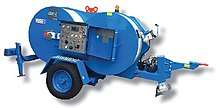
Applications
- Bolt tensioners are devices designed to apply a specific tension to a bolt. The device may be either removed once the actual nut is threaded into place, or left in place, in the case of a hydraulic nut.[1]
- The belt or chain tension on a single-speed bicycle can be maintained by either setting the fixed horizontal position of the rear sprocket or the front chainring horizontally, or by a separate tensioner that pushes perpendicular to the chain with either a fixed position or spring tension.[2]
- The serpentine belt and the timing belt or chain on an automobile engine may be guided by an idler pulley and/or a belt tensioner, which may be spring-loaded, hydraulic, or fixed.[3]
- A marine riser tensioner is a device used on an offshore drilling vessel which provides a near constant upward force on the drilling riser independent of the movement of the floating drill vessel.
- A guideline tensioner is a hydropneumatic device used on an offshore drilling rig that keeps a positive pulling force on the guidelines from the platform to a template on the seabed.
- Overhead electrical wires may be kept in tension by springs or weights.
- Conveyor belts
- Chair lift and gondola lift cables
- Certain wood trusses, such as the beam tensioner truss picture below.[5][6]
- Fencing made of wire, such as electric fences, barbed-wire fences, and chainlink fences often include tensioning devices to keep them taut.
- Belt sanders have a mechanism, often a spring-loaded idler drum, to apply the proper tension to the sanding belt, which can be released to allow for changing belts.[7]
Gallery
- Spring-loaded overhead line tensioner
- Gravity overhead line tensioner
 Chain tensioner in an automobile engine
Chain tensioner in an automobile engine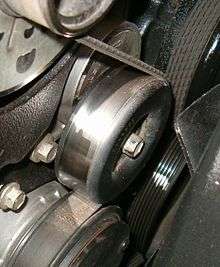 Serpentine belt on belt tensioner in an automobile engine
Serpentine belt on belt tensioner in an automobile engine Adjustable, fixed-position belt tensioner in an automobile engine
Adjustable, fixed-position belt tensioner in an automobile engine- Drum tensioner
 Conveyor belt tensioner
Conveyor belt tensioner- Chair lift cable tensioner
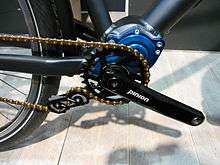 Chain tensioner for a bicycle with an internal gearbox
Chain tensioner for a bicycle with an internal gearbox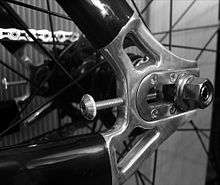 Chain tensioner for a single-speed bicycle
Chain tensioner for a single-speed bicycle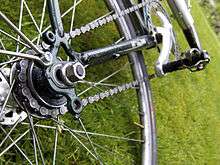 Bicycle chain tensioned without a dedicated tensioner mechanism
Bicycle chain tensioned without a dedicated tensioner mechanism Traditional Finnish frame saw with wooden frame, loggers' tool before cross-cut and chain saws till 1960s
Traditional Finnish frame saw with wooden frame, loggers' tool before cross-cut and chain saws till 1960s Marine riser tensioner
Marine riser tensioner Beam tensioner truss
Beam tensioner truss Chainlink fence tensioner
Chainlink fence tensioner Track tensioner on a Churchill Tank
Track tensioner on a Churchill Tank
See also
References
- "How Hydraulic Tensioners Work". Hydraulics Technology, Inc. 2014. Retrieved 2014-12-29.
- Brown, Sheldon. "Chain Tensioner". Sheldon Brown. Retrieved 2014-12-29.
- "Your Engine 101: Belts and Tensioners". Gates Corporation. 2009. Retrieved 2014-12-29.
- "Homelite 18" Gas Chain Saw Review". Gadget Review. September 1, 2011. Retrieved 2014-12-29.
- "Timber Connectors". MiTek. 2011. Retrieved 2014-12-29.
- "Strap Brace Tensioners". Pryda. 2014. Retrieved 2014-12-29.
- "Belt Sander" (PDF). ShopSmith. Retrieved 2013-12-30.